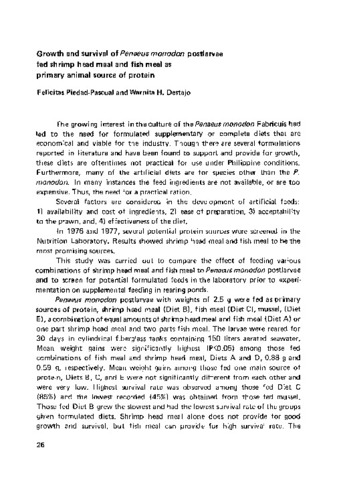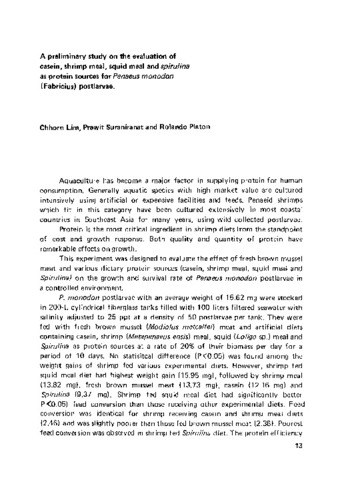Evaluation of leguminous seed meals and leaf meals as plant protein sources in diets for juvenile Penaeus indicus
- Global styles
- MLA
- Vancouver
- Elsevier - Harvard
- APA
- Help

View/
Date
1998Page views
7,516ASFA keyword
AGROVOC keyword
Taxonomic term
Metadata
Show full item record
Share
Abstract
The potential of locally available legumes (white cowpea, Vigna unguiculata, and green mung-bean, Vigna radiata) and leaf meals (papaya, Carica papaya, and cassava, Manihut esculenta) in combination with defatted soybean meal as protein sources was evaluated in juvenile Penaeus indicus. The feedstuffs were included in practical diets for P. indicus, replacing 9% of the protein in the basal diet. Juvenile P. indicus (mean initial weight 0.08±0.01 g) were fed the practical diets for 61 days. Shrimp fed the control diet had the highest weight gain and specific growth rate, which did not significantly differ (p>0.05) from those of shrimp fed white cowpea meal, papaya leaf meal and cassava leaf meal. Survival of the control shrimp was significantly higher (p<0,05) than that of shrimp fed cassava and papaya leaf meals but comparable to that of shrimp fed white cowpea meal. The growth of shrimp given green mungbean meal was comparable to that of shrimp fed papaya leaf meal, however the shrimp fed mungbean meal had the lowest survival.
The apparent protein digestibility (APD) of white cowpea meal (87%) was significantly higher (p<0.05) than that of the control (82%) and cassava leaf meal (77%) based diets . However, the APD of the white cowpea meal based diet was comparable to those of the papaya leaf meal and green mungbean meal based diets. Results suggest that, besides digestibility, other factors such as the amino acid balance of the diet and the amount of anti-nutritional factors may influence the growth and survival of P. indicus.
Suggested Citation
Eusebio, P. S., & Coloso, R. M. (1998). Evaluation of leguminous seed meals and leaf meals as plant protein sources in diets for juvenile Penaeus indicus. The Israeli Journal of Aquaculture-Bamidgeh , 50(2), 47-54. http://hdl.handle.net/10862/1741
Type
ArticleISSN
0792-156XCollections
- Journal Articles [1215]
Related items
Showing items related by title, author, creator and subject.
-
Development and use of alternative ingredients or fish meal substitutes in aquaculture feed formulation: Proceedings of the ASEAN Regional Technical Consultation on Development and Use of Alternative Dietary Ingredients or Fish Meal Substitutes in Aquaculture Feed Formulation
Catacutan, Mae R.; Coloso, Relicardo M.; Acosta, Belen O. (Aquaculture Department, Southeast Asian Fisheries Development Center, 2015)Recognizing the need for a concerted effort to follow-up on this priority issue of the ASEAN on aquaculture feed development and utilization. SEAFDEC (Aquaculture Department and Secretariat) and the Government of Myanmar ... -
Growth and survival of Penaeus monodon postlarvae fed shrimp head meal and fish meal as primary animal source of protein
Piedad-Pascual, Felicitas; Destajo, Warnita H. (Aquaculture Department, Southeast Asian Fisheries Development Center, 1978)Although shrimp head meal alone does not provide for good growth and survival, fish meal can provide high survival rate. The addition of shrimp head improves this diet. It is suggested that cholesterol present in shrimp ... -
A preliminary study on the evaluation of casein, shrimp meal, squid meal and spirulina as protein sources for Penaeus monodon (Fabricius) postlarvae
Lim, Chhorn; Suraniranat, Prawit; Platon, Rolando (Aquaculture Department, Southeast Asian Fisheries Development Center, 1978)P. monodon postlarvae were fed with fresh brown mussel (Modiolus metcalfei) meat, and artificial diets containing casein, shrimp (Metapenaeus ensis) meal, squid (Loligo) meal, and Spirulina as protein sources at a rate of ...





